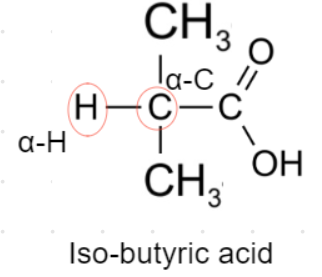
Which of the following compounds does not undergo Hell-Volhard-Zelinsky reaction?
Answer
517.8k+ views
Hint- Here, we will proceed by discussing the Vell Volhard Zelinsky reaction mechanism. Then, we will draw the structures of all the acids given in the options. Those which will be having alpha hydrogen will undergo the reaction.



Complete answer:
An aldehyde or ketone in possession of α hydrogen and its enol tautomer will be in equilibrium. This aldehyde and ketone component allows electrophilic addition to occur at the hydrogen α. However, carboxylic acids usually do not form stable enols, so adding alpha is easier to do with carboxylic acids than with aldehydes and ketones. The reaction from Hell Volhard Zelinsky reveals a process for incorporating alpha with a carboxylic acid. The purpose of the process is to transform the carboxylic acid into a derivative that is subjected to tautomerization and then to apply alpha to it. For this reaction to happen, the given carboxylic acid must have at least one alpha hydrogen present.
So, ethanoic acid will undergo Hell-Volhard Zelinsky reaction.
So, propionic acid will undergo Hell-Volhard Zelinsky reaction.
So, Iso-butyric acid will undergo Hell-Volhard Zelinsky reaction.
So, Trichloroacetic acid will not undergo Hell-Volhard Zelinsky reaction due to the absence of any alpha hydrogen.
Therefore, option D is correct.
Note- For organic molecules, the alpha carbon refers to the first carbon atom that binds to a functional group, such as carbonyl. The atom of hydrogen bound to an alpha atom of carbon is considered an alpha-hydrogen molecule. The Hell Volhard Zelinsky reaction mechanism is somewhat distinct from other reactions to halogenation, because it occurs in the absence of a halogen carrier.



Complete answer:
An aldehyde or ketone in possession of α hydrogen and its enol tautomer will be in equilibrium. This aldehyde and ketone component allows electrophilic addition to occur at the hydrogen α. However, carboxylic acids usually do not form stable enols, so adding alpha is easier to do with carboxylic acids than with aldehydes and ketones. The reaction from Hell Volhard Zelinsky reveals a process for incorporating alpha with a carboxylic acid. The purpose of the process is to transform the carboxylic acid into a derivative that is subjected to tautomerization and then to apply alpha to it. For this reaction to happen, the given carboxylic acid must have at least one alpha hydrogen present.
So, ethanoic acid will undergo Hell-Volhard Zelinsky reaction.
So, propionic acid will undergo Hell-Volhard Zelinsky reaction.
So, Iso-butyric acid will undergo Hell-Volhard Zelinsky reaction.
So, Trichloroacetic acid will not undergo Hell-Volhard Zelinsky reaction due to the absence of any alpha hydrogen.
Therefore, option D is correct.
Note- For organic molecules, the alpha carbon refers to the first carbon atom that binds to a functional group, such as carbonyl. The atom of hydrogen bound to an alpha atom of carbon is considered an alpha-hydrogen molecule. The Hell Volhard Zelinsky reaction mechanism is somewhat distinct from other reactions to halogenation, because it occurs in the absence of a halogen carrier.
Latest Vedantu courses for you
Grade 7 | CBSE | SCHOOL | English
Vedantu 7 CBSE Pro Course - (2025-26)
School Full course for CBSE students
₹45,300 per year
Recently Updated Pages
Master Class 12 Economics: Engaging Questions & Answers for Success

Master Class 12 Maths: Engaging Questions & Answers for Success

Master Class 12 Biology: Engaging Questions & Answers for Success

Master Class 12 Physics: Engaging Questions & Answers for Success

Master Class 4 Maths: Engaging Questions & Answers for Success

Master Class 4 English: Engaging Questions & Answers for Success

Trending doubts
Give 10 examples of unisexual and bisexual flowers

Draw a labelled sketch of the human eye class 12 physics CBSE

a Tabulate the differences in the characteristics of class 12 chemistry CBSE

Differentiate between homogeneous and heterogeneous class 12 chemistry CBSE

Why is the cell called the structural and functional class 12 biology CBSE

Differentiate between insitu conservation and exsitu class 12 biology CBSE




